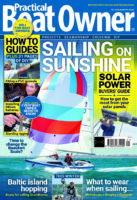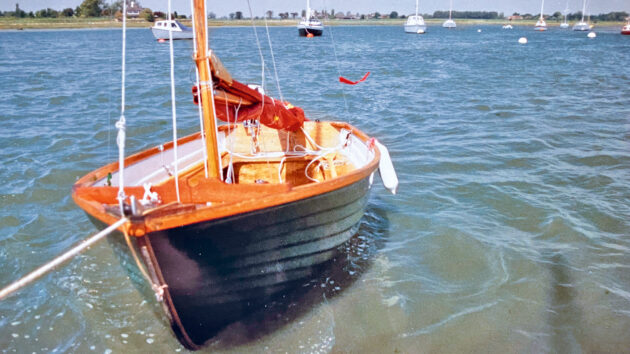Clive Marsh tells the story of how he came across an Invicta 12, the classic dinghy that started his small boat collection, and how it taught him the importance of a tight snotter.
There’s only the Invicta 12 to blame for getting me into collecting small boats.
New Zealand is one of the better places to go boating but I was not based in Auckland and had little time off work or easy access to launch facilities. I lived in Wellington, which is not the easiest of places for small boat sailing.
So, after eight years of being boat-less, the first thing I did on moving back to the Rye area was to explore the boatyards and launching facilities on the Rother.
Sitting on her trailer in the corner of Sea Cruisers’ chandlery and boat yard was a traditional 12ft gunter rigged sailing dinghy in low maintenance GRP. I snapped her up for £650 and towed her home to prepare her for the season. I was attracted by her simple working boat lines.
She was an Invicta 12 designed and built by Brian Cory in the early 1970s. In all about 25 of these boats were built either as centreboard sailing dinghies or as small motor fishing boats.
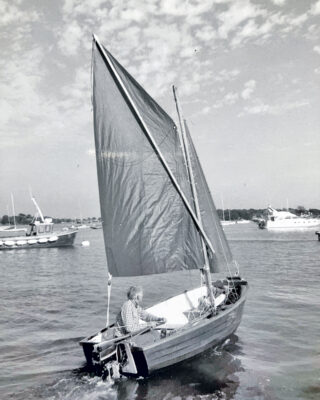
The Invicta 12 with modified sprit rig being motor-sailed by Maurice. Photo: Clive Marsh.
The family business behind the Invicta 12
Having built himself an Enterprise sailing dinghy in 1957, Brian Cory, an avid sailor, developed a passion for boatbuilding, and Cory Yachts has been building boats since 1966; from racing dinghies to cruising motorboats, every boat is built with craftsmanship and passion.
Brian’s son, Simon, joined the firm and is now at the helm of the business. Brian’s sailing background must have been a useful experience for a boatbuilder.
Simon has a long list of yacht and dinghy racing achievements including winning four national championships and a Eurocup. He has sailed his own yacht Cool Blue at Cowes Weeks, being second and third in class regularly. He has also cruised Cool Blue extensively across Europe. Building boats since 1985, Simon is also a highly experienced designer and boatbuilder.
The little Invicta 12 reflects all this Cory pedigree. A fine little working boat, well fitted with everything in the right place and totally functional.
If you want a quality traditional dinghy, Invicta 12s do come on the market from time to time. The last one built was in 1990.
Purchasing the Invicta 12 on a whim
On return to the chandlery at Rye, for some bearing grease, I noticed another little sailboat in the corner of the yard. This boat had a bit more room for the family and a cuddy cabin so I brought her home with the grease.
I now had two boats on the drive and Brenda was beginning to get suspicious.
I still have no idea what type or make of boat this was. She was named Clarion, maybe one of our readers can recognise her from the photo below.
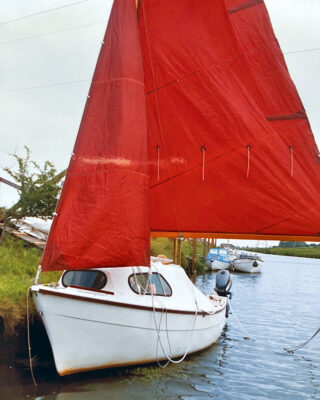
Clive bought Clarion but has no idea what type of boat she was. Photo: Clive Marsh.
I took her to Chichester and launched from the hard at Bosham. She was a handy little boat and on return I noticed a Westerly Cirrus for sale in Bosham boat yard at a very reasonable price and, after some negotiating with Brenda, I bought her, giving assurances that
I would get rid of at least one other boat.
Of course, it didn’t work out exactly like that because the Westerly, being a fin keeler, needed a decent tender big enough for four people. An Orkney Angler was perfect…
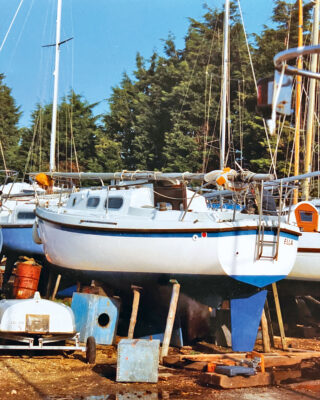
Clive’s Westerly Cirrus led to him buying an Orkney Angler as a tender. Photo: Clive Marsh.
Back to the Invicta 12, my friend Maurice took her and, being a boatbuilder, he decided to experiment with her rig and converted her to a sprit sail. Eventually, he added a bow sprit and further converted her into a gaff-rigged cutter with a topsail.
There was nothing wrong with the original gunter rig, but Maurice likes to experiment. One big advantage of the sprit rig is that the entire sail can be quickly braided to the mast and there is no boom and sail to clutter up the cockpit when the sail is put away. This makes rowing easier, and the Invicta 12 is a good boat to row.
Another significant advantage is the ability of a sprit rig to flatten an old sail, helping windward performance. The compact shape of a sprit sail has less tendency to heel the boat and most boats sail better and faster when upright.
A small 2hp motor is adequate for an Invicta 12 if you feel the need for an engine.
Snotters need a stopper
The sprit sail rig, which is used on Thames sailing barges, is rarely seen on small dinghies. I often wonder why, as it’s such a handy and safe rig.
The sprit sail is generally close to being a rectangle with the top rear corner being angled and pushed up by a pole called a sprit. A line is attached to the lower rear corner of the sail and goes up to the front top corner of the sail. This enables the sail to be put away easily and is a great asset when dinghy cruising and sailing in tight conditions where you might need to put away the sail quickly.
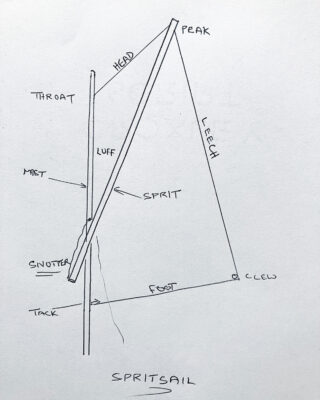
The sprit rig stows neatly, braided to the mast. Photo: Clive Marsh.
Don’t forget that a snotter needs a stopper to prevent it from driving down a heavy yard and making a hole in the bottom of your hull!
Adjustment needed
A tight snotter will cure a saggy head!
I once rigged a Sussex Punt with a sprit sail and it was very handy in the narrow tidal Rother.
To get the best out of the sail to windward it is necessary to keep the snotter tight, it has a way of working loose and needs regular adjustment which is all part of the fun. The sketch demonstrates the essential parts of a sprit rig.
Note that the head of the sail needs to be stretched good and tight from the masthead to the peak. This will enable the boat to point higher. A saggy peak will result in the sail becoming out of shape.
A sprit rig only needs a short mast which makes life easier when stepping or taking it down.
If you have a sprit sail without a boom you must get the sheeting angle such that it splits the clew angle in equal parts. If the boat is not long enough to do this then you’ll need a bumpkin or a boom or possibly a spritsail with a sprit boom.
The Invicta 12 is not in current production and is not a well-known brand, so you can expect it to cost a lot less than some alternatives.
Clive Marsh discovered small boats while working for Canadian Pacific Steamships and is a past Commodore of the Merchant Navy Association Boat Club. In this series he shares tales from his 50 years of boat ownership.
Want to read more articles on small boats like the Invicta 12?

A subscription to Practical Boat Owner magazine costs around 40% less than the cover price.
Print and digital editions are available through Magazines Direct – where you can also find the latest deals.
PBO is packed with information to help you get the most from boat ownership – whether sail or power.
-
-
-
- Take your DIY skills to the next level with trusted advice on boat maintenance and repairs
- Impartial, in-depth gear reviews
- Practical cruising tips for making the most of your time afloat
-
-
Follow us on Facebook, Instagram, TikTok and Twitter

